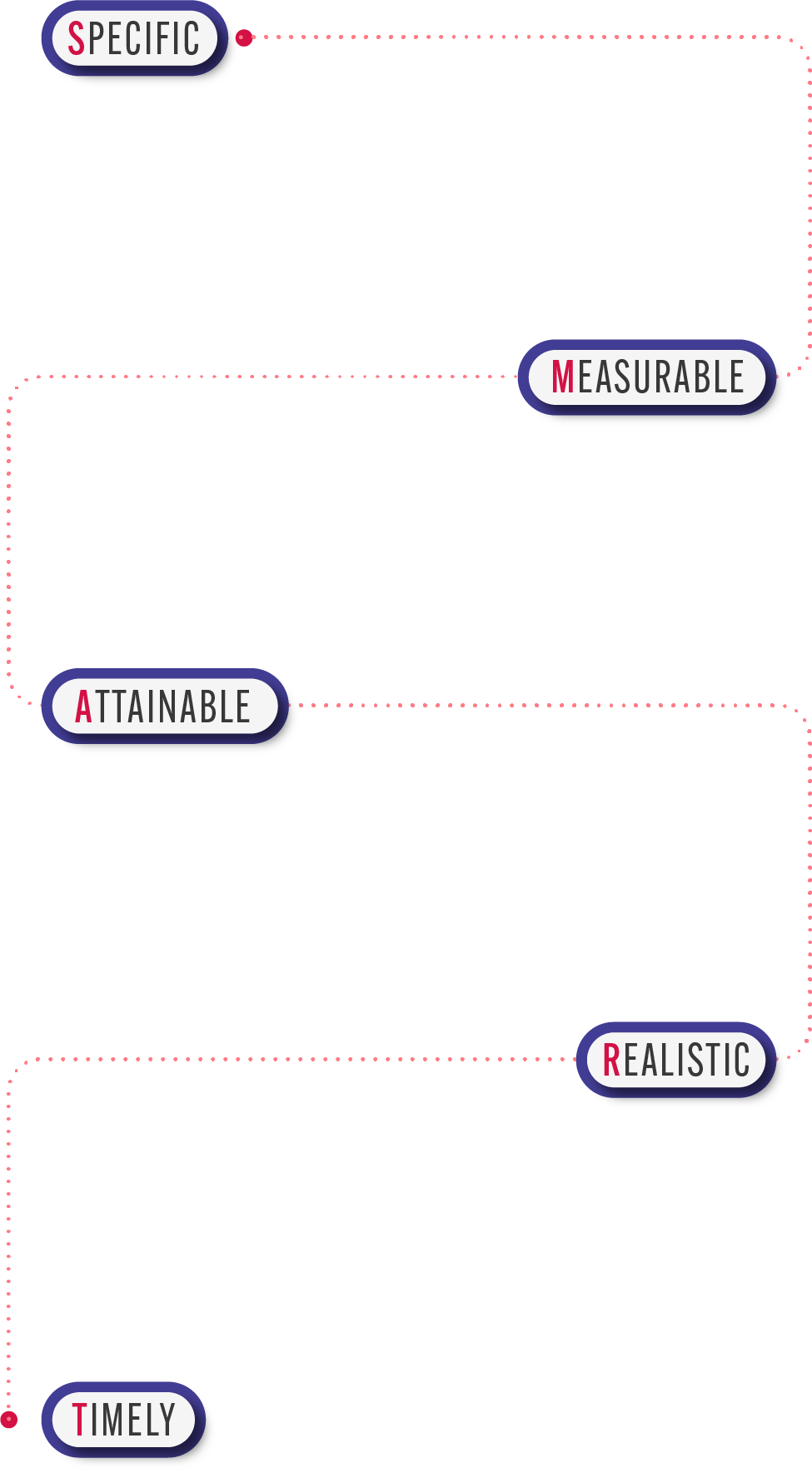Related articles
The Smart Way To Plan Your Finances


The SMART Way
To Plan Your Finances
Taking control of your financial life requires planning, and that starts with setting goals. This is an important step to achieve financial freedom and if you aren’t working towards anything specific, you’re likely to spend more than you should.
How many surprises do you encounter in life regarding your finances; unexpected car problems, medical bills, house emergencies? Whether you want to pay off your credit card debt, save for retirement, or buy a house one day, personal financial planning is the key to achieving your goals.
One of the best ways to do this is through the SMART method.



The SMART Way
Way to Plan Your Finances
Taking control of your financial life requires planning, and that starts with setting goals. This is an important step to achieve financial freedom and if you aren’t working towards anything specific, you’re likely to spend more than you should.
How many surprises do you encounter in life regarding your finances; unexpected car problems, medical bills, house emergencies? Whether you want to pay off your credit card debt, save for retirement, or buy a house one day, personal financial planning is the key to achieving your goals.
One of the best ways to do this is through the SMART method.


What is
SMART
?SMART is an acronym which stands for:

Specific

Measurable

Attainable

Realistic

Timely

Be specific with what you want. Having specifics on how and when you’ll save up, makes it much easier to manage and grow your savings account.
First, ask yourself what you want and how much will that be. This is so you have a reason to focus on as you are building your savings. It can be anything, from starting an emergency fund or paying off a debt – by setting a specific goal, you’ll be able to focus on a solid target.


Make sure it is measurable. Write the figure down. When your goals are measurable, you can make checkpoints along the way to keep track of your progress.
Say you have RM3,000 of credit card debt to pay, set your goal at RM3,000 and work towards paying it off. Seeing your credit card debt shrink will also inspire you to keep moving forward.


Keep it achievable and not completely out of reach. While you want to make your goals big and a bit of a challenge, you also want to be careful to keep them in arm’s reach.
Ask yourself if you can stay on track and achieve your goals or if your plan is feasible in the long run? If you set your goals too high at the start, you might find it much harder to achieve your target. Therefore, take a look at your income and expenses to see how much you can afford to save.


While there might be some overlap between being achievable and realistic, the two are inherently different as being achievable means to ask the question of whether or not you can reach your specific goal either right now or in the future. Whereas being realistic is to ask if that goal makes sense for your situation now and in the future.
Setting realistic goals is also known as living within your means. Instead of saving RM1 million, challenge yourself to save a sum of money that your budget affords. Once you’ve achieved that goal, try setting a goal for a larger sum or for a longer period of time.


Make sure that they are timely goals that can keep you focused. By placing a timeline on your goals, you’re ensuring that you are taking action within a specific time period and this keeps you focused on your target.
Adding timelines to your goals helps you measure your progress by giving you ‘check-ins’ at regular intervals leading up to timestamp. They also help motivate you because every time you hit your ‘check-ins’ you are moving forward.


Now that you understand how SMART financial goal works, what’s next? Put this method into practice with a comprehensive investment plan and achieve the financial freedom you’ve been yearning for! Remember not to rush and trust the process.
All the best!
https://www.wealthspire.com/blog/get-smart-personal-financial-goals
https://nomoredebts.org/blog/budgeting-saving/what-does-it-mean-to-set-smart-financial-goals
https://ringgitplus.com/en/blog/budgeting-saving/kick-start-your-money-goals.html

What is
SMART
?SMART is an acronym which stands for:

Specific
Measurable
Attainable
Realistic
Timely


Be specific with what you want. Having specifics on how and when you’ll save up, makes it much easier to manage and grow your savings account.
First, ask yourself what you want and how much will that be. This is so you have a reason to focus on as you are building your savings. It can be anything, from starting an emergency fund or paying off a debt – by setting a specific goal, you’ll be able to focus on a solid target.



Make sure it is measurable. Write the figure down. When your goals are measurable, you can make checkpoints along the way to keep track of your progress.
Say you have RM3,000 of credit card debt to pay, set your goal at RM3,000 and work towards paying it off. Seeing your credit card debt shrink will also inspire you to keep moving forward.
Keep it achievable and not completely out of reach. While you want to make your goals big and a bit of a challenge, you also want to be careful to keep them in arm’s reach.
Ask yourself if you can stay on track and achieve your goals or if your plan is feasible in the long run? If you set your goals too high at the start, you might find it much harder to achieve your target. Therefore, take a look at your income and expenses to see how much you can afford to save.



While there might be some overlap between being achievable and realistic, the two are inherently different as being achievable means to ask the question of whether or not you can reach your specific goal either right now or in the future. Whereas being realistic is to ask if that goal makes sense for your situation now and in the future.
Setting realistic goals is also known as living within your means. Instead of saving RM1 million, challenge yourself to save a sum of money that your budget affords. Once you’ve achieved that goal, try setting a goal for a larger sum or for a longer period of time.
Make sure that they are timely goals that can keep you focused. By placing a timeline on your goals, you’re ensuring that you are taking action within a specific time period and this keeps you focused on your target.
Adding timelines to your goals helps you measure your progress by giving you ‘check-ins’ at regular intervals leading up to timestamp. They also help motivate you because every time you hit your ‘check-ins’ you are moving forward.



Be specific with what you want. Having specifics on how and when you’ll save up, makes it much easier to manage and grow your savings account.
First, ask yourself what you want and how much will that be. This is so you have a reason to focus on as you are building your savings. It can be anything, from starting an emergency fund or paying off a debt – by setting a specific goal, you’ll be able to focus on a solid target.



Make sure it is measurable. Write the figure down. When your goals are measurable, you can make checkpoints along the way to keep track of your progress.
Say you have RM3,000 of credit card debt to pay, set your goal at RM3,000 and work towards paying it off. Seeing your credit card debt shrink will also inspire you to keep moving forward.

Keep it achievable and not completely out of reach. While you want to make your goals big and a bit of a challenge, you also want to be careful to keep them in arm’s reach.
Ask yourself if you can stay on track and achieve your goals or if your plan is feasible in the long run? If you set your goals too high at the start, you might find it much harder to achieve your target. Therefore, take a look at your income and expenses to see how much you can afford to save.



While there might be some overlap between being achievable and realistic, the two are inherently different as being achievable means to ask the question of whether or not you can reach your specific goal either right now or in the future. Whereas being realistic is to ask if that goal makes sense for your situation now and in the future.
Setting realistic goals is also known as living within your means. Instead of saving RM1 million, challenge yourself to save a sum of money that your budget affords. Once you’ve achieved that goal, try setting a goal for a larger sum or for a longer period of time.

Make sure that they are timely goals that can keep you focused. By placing a timeline on your goals, you’re ensuring that you are taking action within a specific time period and this keeps you focused on your target.
Adding timelines to your goals helps you measure your progress by giving you ‘check-ins’ at regular intervals leading up to timestamp. They also help motivate you because every time you hit your ‘check-ins’ you are moving forward.


Now that you understand how SMART financial goal works, what’s next? Put this method into practice with a comprehensive investment plan and achieve the financial freedom you’ve been yearning for! Remember not to rush and trust the process.
All the best!

https://www.wealthspire.com/blog/get-smart-personal-financial-goals
https://nomoredebts.org/blog/budgeting-saving/what-does-it-mean-to-set-smart-financial-goals
https://ringgitplus.com/en/blog/budgeting-saving/kick-start-your-money-goals.html
